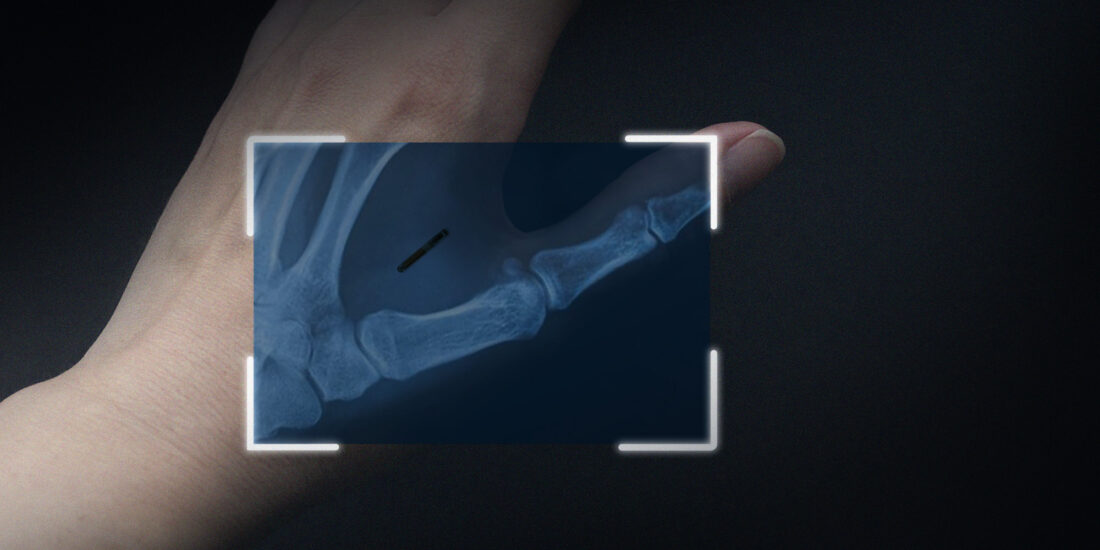Security Concerns from Biohacking & Implanted Microchips
- Written by: Trevor Meers

In the right circumstances, a biohacker may only need to wave their hand to break into your building or attack your network. The technology at work isn’t all that new, but its location is. It’s now shockingly easy to implant a microchip in your own body and use it to access (and potentially hack) a wide variety of devices.
During a session at the 2021 Secure Iowa conference, Senior Penetration Tester Jason Moulder demonstrated what’s possible in this version of biohacking. With four chips embedded in his own hands, Jason had a lot of data resting on the podium as he spoke.
How Implanted Chips Work
When Jason asked what comes to mind when you imagine implanted chips, several people shouted, “Terminator!” And they’re not wrong. Technically speaking, putting anything inorganic into your body makes you a cyborg. In simple terms, Jason said, biohacking, “Is just a desire to go beyond what you can normally do.”
But as edgy as they sound, implanted microchips are actually a simple matter of putting technology you already use under your skin instead of in your pocket. The chips use the same RFID (radio frequency ID) technology you’re familiar with in proximity cards such as your office ID or hotel room keys. RFID also pops up throughout your life in credit cards, toll booth tags, key fobs, luggage tracking in airports and more. Millions of pets carry implanted chips in case they get lost. And the medical community already leverages implantable chips with devices such as glucose-monitoring systems for people with diabetes.
The chips, which are typically not powered, communicate over short distances with the reader, and an implanted chip can carry anything a card can. That means you could use a chip to open locked doors at the office, give your boarding pass to an airport agent, buy items from a vending machine, log into a cash machine, tell your smartphone to call up a favorite website and much more.
Your own personal tastes will determine whether handling transactions with your hand sounds wildly convenient or mostly creepy. In some other countries (most famously Sweden), thousands of people have had chips implanted. A couple of years ago, Sweden’s largest chipping company couldn’t keep up with the demand.
How Chips are Implanted
The first person known to receive a microchip implant was a British scientist named Kevin “Captain Cyborg” Warwick in 1998. Today, you can join Captain Cyborg’s super friends simply by ordering your own implant kit online. Jason buys his at Dangerous Things, which offers bundles including the Ultimate Implant Bundle with three chips for $260.
If you get even remotely squeamish around needles, chip implants won’t be your jam. Kits come with plungers and large needles so you can inject the chip, which typically comes in a glass tube about the size of a grain of rice. (It’s worth noting that Dangerous Things’ web store includes several pain-management products.) Most users place the chips on the back of their hand beside the thumb for easy access to chip readers.
You can watch the implant process here, along with watching a journalist starting to realize that he may want to keep his new chip even after his experiment is over.
Jason says the chips he’s carrying around are guaranteed to last 50 years. What if you change your mind about the chip or technology makes your implant obsolete? Well, take a deep breath. Dangerous Things offers a scalpel set.
How Hackers Can Use Implanted Chips
Back in 2015, a security expert was already hacking into smartphones using an implanted chip originally designed for cattle. So without a doubt, a hacker could leverage a chip to breach a building or computer system. Again, they leverage familiar RFID technology. And Jason notes that most RFID access systems are vulnerable because most companies buy the cheapest unit that meets their compliance requirements. “Most businesses have a mentality that they’re just checking the box,” rather than truly looking for a secure solution, Jason says.
To make his point during his presentation, Jason quickly broke into a virtual hotel room by transferring the code from a proximity card onto the chip in his hand. In under five minutes, his chip produced a green light on the card reader he brought along. Then he demonstrated how he can transfer malware from his implanted chip to a phone, creating a foothold to start pivoting through the larger system connected to the phone.
You can also load scripts onto a chip, “which is where it starts becoming dangerous from my perspective,” Jason says. You can use a chip to log into a computer, open the browser and navigate to a certain site.
How Risky are Chips Today – Really?
It’s fairly obvious that implanted chips are a bit of a novelty act at this point. You could accomplish the same things with a card or even a chip tucked into the seam of your shirt cuff, etc. But in an extremely security-conscious facility, you could envision scenarios involving extensive searches of visitors, metal detectors, etc. It’s not often that an implanted chip would represent the only way to circumvent security, but it’s not hard to imagine such a situation.
Realistically, you’re already giving away far more information than you need to worry about with chips. “If anybody really wants to find you,” Jason says, “they can just track you on social media. We use that all the time in our jobs as penetration testers because people are always tagging people, checking in at places, etc. We can build a profile of you with all that.” And, of course, nearly everyone already voluntarily carries a powerful tracking device in the shape of their smartphone.
Implanted microchips may grab attention by scratching a sci-fi itch. But whether someone is attempting to breach your system with a chip or a card, the core principles of good security still apply.
You can download a copy of Jason’s full presentation here.
If you need help reviewing the implications of chip implants and other threats for your security, contact HBS for a free consultation.






